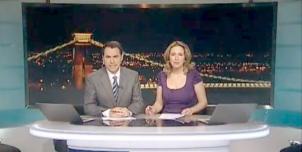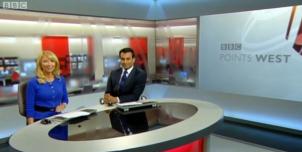Full Freeview on the Mendip (Somerset, England) transmitter
| Google Streetview | Google map | Bing map | Google Earth | 51.237,-2.626 or 51°14'12"N 2°37'33"W | BA5 3LB |
The symbol shows the location of the Mendip (Somerset, England) transmitter which serves 720,000 homes. The bright green areas shown where the signal from this transmitter is strong, dark green areas are poorer signals. Those parts shown in yellow may have interference on the same frequency from other masts.
This transmitter has no current reported problems
The BBC and Digital UK report there are no faults or engineering work on the Mendip (Somerset, England) transmitter._______
Digital television services are broadcast on a multiplexes (or Mux) where many stations occupy a single broadcast frequency, as shown below.
64QAM 8K 3/4 27.1Mb/s DVB-T MPEG2
DTG-12 QSPK 8K 3/4 8.0Mb/s DVB-T MPEG2
H/V: aerial position (horizontal or vertical)
Which Freeview channels does the Mendip transmitter broadcast?
If you have any kind of Freeview fault, follow this Freeview reset procedure first.Digital television services are broadcast on a multiplexes (or Mux) where many stations occupy a single broadcast frequency, as shown below.
64QAM 8K 3/4 27.1Mb/s DVB-T MPEG2
DTG-12 QSPK 8K 3/4 8.0Mb/s DVB-T MPEG2
H/V: aerial position (horizontal or vertical)
Which BBC and ITV regional news can I watch from the Mendip transmitter?

ITV West Country News (East) 0.9m homes 3.4%
from Bristol BS4 3HG, 23km north (11°)
to ITV West region - 61 masts.
All of lunch, weekend and 50% evening news is shared with West Country (West)
Are there any self-help relays?
| Cheddar | Transposer | 15 km E Weston-super-Mare | 1674 homes |
| Luccombe | Active deflector | 6 km w Minehead | 38 homes |
How will the Mendip (Somerset, England) transmission frequencies change over time?
| 1984-97 | 1997-98 | 1998-2010 | 2010-13 | 2013-18 | 2013-17 | 27 Feb 2018 | |||
| C/D E | E | E | C/D E | C/D E T | W T | W T | |||
| C30 | _local | ||||||||
| C32 | BBCA | ||||||||
| C33 | com7 | com7 | |||||||
| C34 | D3+4 | ||||||||
| C35 | com8 | com8 | |||||||
| C36 | ArqB | ||||||||
| C37 | C5waves | C5waves | |||||||
| C48 | SDN | SDN | SDN | SDN | |||||
| C49tv_off | BBCA | BBCA | |||||||
| C51tv_off | LBS | LBS | |||||||
| C52tv_off | ArqB | ArqB | ArqB | ||||||
| C54tv_off | C4waves | C4waves | C4waves | D3+4 | D3+4 | D3+4 | |||
| C55tv_off | com7tv_off | ||||||||
| C56tv_off | ArqA | ArqA | ArqA | COM8tv_off | |||||
| C58tv_off | BBC1waves | BBC1waves | BBC1waves | BBCB | BBCB | BBCB | |||
| C61 | ITVwaves | ITVwaves | ITVwaves | BBCA | |||||
| C64 | BBC2waves | BBC2waves | BBC2waves |
tv_off Being removed from Freeview (for 5G use) after November 2020 / June 2022 - more
Table shows multiplexes names see this article;
green background for transmission frequencies
Notes: + and - denote 166kHz offset; aerial group are shown as A B C/D E K W T
waves denotes analogue; digital switchover was 24 Mar 10 and 7 Apr 10.
How do the old analogue and currrent digital signal levels compare?
| Analogue 1-4 | 500kW | |
| Analogue 5 | (-6dB) 126kW | |
| SDN, ARQA, ARQB, BBCA, D3+4, BBCB | (-7dB) 100kW | |
| com7 | (-8.4dB) 72.4kW | |
| com8 | (-8.6dB) 69.1kW | |
| Mux 1*, Mux 2*, Mux A*, Mux B*, Mux C*, Mux D*, LBS | (-17dB) 10kW |
Which companies have run the Channel 3 services in the Mendip transmitter area
|
|
Sunday, 15 May 2016
T
Tim11:11 PM
To MikeP, re: amplification, log periodics have less gain than banded "contract" yagi aerials and so a masthead amp is generally recommended, some coming with them built in. They have the benefit of wideband reception and also a tighter focus on the transmitter with better rejection of "noises off", but need an amp to produce the same output as a yagi. I agree about "digital" aerials, all signals are transmitted in analogue form ultimately.
| link to this comment |
Monday, 16 May 2016
MikeP
2:14 PM
Trowbridge
2:14 PM
Trowbridge
Tim:
Agreed if the log-periodic is not large enough. If, however, one of sufficient elements is used then no amplification is needed. That is the better solution as an amplified will not on;y increase the wanted signal strength but also any unwanted signals as well! So iis, and always has been, better to use an aerial of sufficient inherent gain. Log-periodics are available with many elements, I know of 36 element types (see http://www.trade-works.co…625) and there may well be some available with up to 72 elements. Most seem to be 20, 22 or 28 element which may not give sufficient inherent gain, but rather than adding noise with an amplifier it is always better top swap the aerial for a higher gain design.
| link to this comment |
MikeP's: mapM's Freeview map terrainM's terrain plot wavesM's frequency data M's Freeview Detailed Coverage
T
Tim3:14 PM
To MikeP: I have a Vision log periodic V10-040, the predecessor to the one you link to, see a picture here (not mine): http://www.satcure.co.uk/…shed . See here for an explanation of the gain differences between log periodics and more commonplace aerials: http://www.satcure.co.uk/…raph - see how even a "Rolls Royce" log periodic's output is much lower than a Yagi's. The point of the amp is not to amplify the received signal and noise (providing little benefit as you say) but to help overcome losses by boosting the signal for a noisy, lossy and often long downlink cable, which can be very lossy at UHF frequencies, when using an aerial producing less gain. On aggregate this arrangement with a log periodic produces better results than a Yagi. If the downlink cable is short, like the shed installation, then it is unlikely to be of much benefit.
| link to this comment |
Tuesday, 17 May 2016
D
David12:04 PM
I'm in Bath (BA1), high up with a high gain, wide band ariel pointing at Mendip transmitter, which feeds various rooms in my house via an indoor distribution amp. I've always had strong reception but in the last few weeks a number of channels (eg Sky news, Dave, Yesterday, E4, Pick etc) have poor signal, lots of pixellating, sometimes zero signal. There seem to be no reports of transmitter problems, visibly ariel looks OK and I get 100% signal on the 'good' stations. This is common to all TVs and PVRs in the house. Retuning makes no difference. Any ideas anyone? Or anyone else in the area with the same problem? Thanks.
| link to this comment |
M
MikeB9:09 PM
David: The clue is probably the 100% on good channels. We have no idea how close you are to the transmitter, but if your close with a amp, then you can overload the tuner - and too much signal looks much the same as none. Check your signal elvels, and then look up 'too much of a good thing' on this site
| link to this comment |
MikeB's: mapM's Freeview map terrainM's terrain plot wavesM's frequency data M's Freeview Detailed Coverage
Wednesday, 18 May 2016
MikeP
9:29 AM
Trowbridge
9:29 AM
Trowbridge
Tim:
Using a higher gain log-periodic obviates the need for any amplification. That has been my professional experience over 50 years in the TV industry!
Amplifiers amplify everything - wanted signal as well as noise.
| link to this comment |
MikeP's: mapM's Freeview map terrainM's terrain plot wavesM's frequency data M's Freeview Detailed Coverage
MikeP
9:39 AM
Trowbridge
9:39 AM
Trowbridge
David and MikeB:
Bath is approximately North West of Mendip and only about 14 miles away, so signals shlould not need any amplification.
As MikeB states, a signal strength of 100% is too strong and will oberload the tuner, causing picture and/or sound breakup or even apparent loss of signal. Fo most equipment a strength between 60% and 80% is ideal.
| link to this comment |
MikeP's: mapM's Freeview map terrainM's terrain plot wavesM's frequency data M's Freeview Detailed Coverage
D
David10:30 AM
Cheers Guys. I'm aware of all that! Though close to Mendip, Bath is surrounded by hills and thus has a local submast. Trouble with this is that it can only accomodate a small number of the available freeview channels and so most of us high enough point our ariels at Mendip. What i can't understand is that while I've been able to receive all channels for years with no problems its just in the last few weeks my problems have begun! What's changed? Mast and booster were installed professionally and signal strength tested good with booster but inadequate without, and I need distro amp to feed signal to 5 rooms! Ah well, will keep investigating!
| link to this comment |
MikeP
3:07 PM
Trowbridge
3:07 PM
Trowbridge
David:
One thing you might try, but no quarantees it will resolve the issue, is to add an attenuator *after* your first amplifier. That will reduce the signal level (and that of any 'noise') entering the distribution amplifier. The overall effect should be to reduce the excessive signal level arriving at the receivers. Coaxial attenuators are inexpensive and available in various strengths (typically 3 dB, 6 dB, 12 dB and 18 dB), so try a 6 dB one first. If that is still allowing too much signal (over 80%) then you can add another in series. If it is too much reduction (signal strength drops below 50%) then try a 3 dB type instead. You can combine attenuators of different strengths until you get the required result.
The 'local' transmitter for Bath is a Freeview Lite intended to serve mainly those areas shielded from Mendip by the hills.
Though I am on Mendip and have no problems, there could possibly be some temperature inversion effects perhaps. Do any or your immediate neighbours have the same problem?
| link to this comment |
MikeP's: mapM's Freeview map terrainM's terrain plot wavesM's frequency data M's Freeview Detailed Coverage
T
Tim11:06 PM
To MikeP, you are right that amplifiers amplify the signal and noise, even with a little more noise added by the amp itself, but when amplifying the signal prior to a lossy link, e.g. a downlink cable or even a mast-to-antenna link like Mendip to Chippenham amplified to 100kW (still with noise beforehand or course), it boosts the signal over the noise of the path so that the ratio at the receiving end is improved. Perhaps it wasn't expressed so clearly but I'm sure that x years of experience will not be lost on this point. So my advice to Dr. Harvey in Chippenham is still to use an amp unless the downlink is short. Too many parts of the town have antennae on such long masts that are testimony to the shadowing of the intervening terrain around Corsham and nearer to be able to have total confidence in not using one. A signal path predictor which also takes the earth's curvature into account can be found here: Terrain - shows radio profile between two UK sites to optimise you DTT, Freeview, DAB or analogue TV reception .
| link to this comment |
Select more comments
Your comment please






